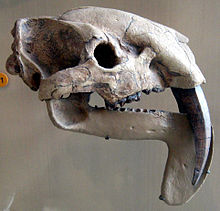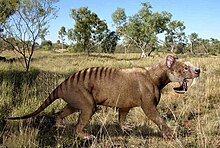| Thylacosmilidae | |
|---|---|

| |
| Thylacosmilus skull | |

| |
| Thylacosmilus atrox paleoart | |
| Scientific classification | |
| Domain: | Eukaryota |
| Kingdom: | Animalia |
| Phylum: | Chordata |
| Class: | Mammalia |
| Order: | †Sparassodonta |
| Superfamily: | †Borhyaenoidea |
| Family: | †Thylacosmilidae Riggs 1933 |
| Genera | |
| |
| Synonyms | |
|
Thylacosmilinae Riggs 1933 | |
Thylacosmilidae is an extinct family of metatherian predators, related to the modern marsupials, which lived in South America between the Miocene and Pliocene epochs. Like other South American mammalian predators that lived prior to the Great American Biotic Interchange, these animals belonged to the order Sparassodonta, which occupied the ecological niche of many eutherian mammals of the order Carnivora from other continents. The family's most notable feature are the elongated, laterally flattened fangs, which is a remarkable evolutionary convergence with other saber-toothed mammals like Barbourofelis and Smilodon.[1]